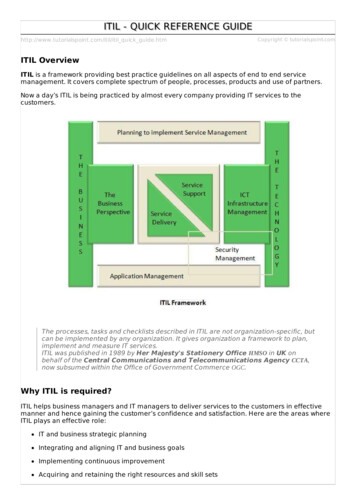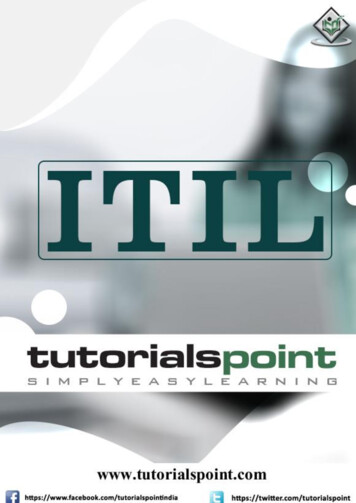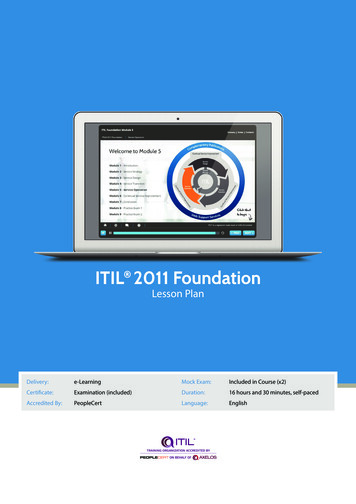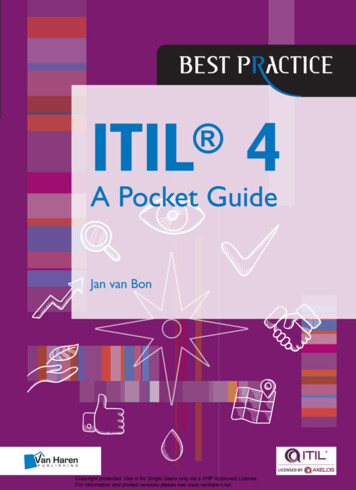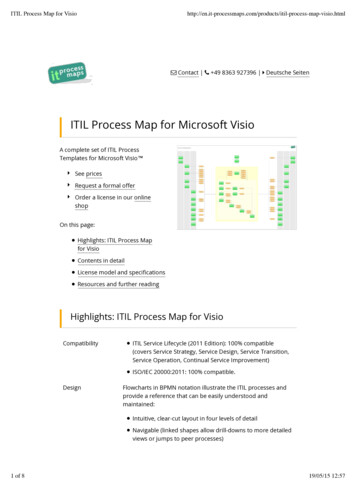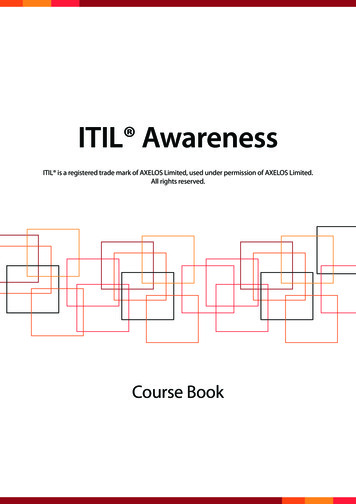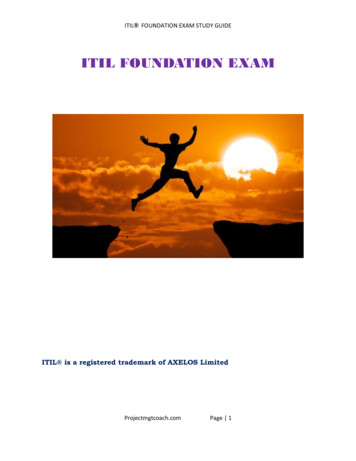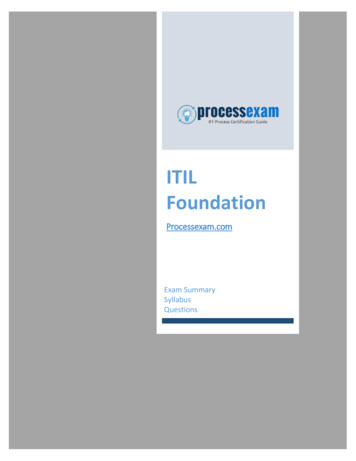
Transcription
ITILFoundationProcessexam.comExam SummarySyllabusQuestions
ITIL Foundation Sample Questions and ExamSummaryTable of ContentsKey to success in ITIL Foundation Exam . 2ITIL Foundation Certification Details:. 2ITIL Foundation Exam Syllabus: . 2ITIL Foundation Sample Questions: . 9Answers to ITIL Foundation Exam Questions: . 10ITIL Foundationpg. 1
ITIL Foundation Sample Questions and ExamSummaryKey to success in ITIL Foundation ExamTo achieve the professional designation of ITIL Foundation, candidates must clear theITIL Foundation Exam with the minimum cut-off score. For those who wish to pass theITIL Foundation certification exam with good percentage, please take a look at thefollowing reference document detailing what should be included in ITIL Foundation Exampreparation.The ITIL Foundation Exam Summary, Body of Knowledge (BOK) and Sample QuestionBank, provide the basis for the real ITIL Foundation exam. If you have made this decisionto become a certified professional, it is advisable to take authorized training and preparewith an online ITIL Foundation Practice Exam to achieve the best result. We havedesigned these resources to help you get ready to take ITIL Foundation (ITIL Foundation)exam.ITIL Foundation Certification Details:Exam NameITIL FoundationExam CodeITIL FoundationExam FeeUSD 150Exam Duration60 MinutesNumber of Questions40Passing Score65%FormatMultiple ChoiceSample QuestionsITIL Foundation Exam Sample Questions and AnswersPractice ExamITIL Foundation Practice TestITIL Foundation Exam Syllabus:UnitService managementas a practiceContentThe purpose of this unit is to help the candidate to definethe concept of a service, and to comprehend and explainthe concept of service management as a practice.ITIL Foundationpg. 2
ITIL Foundation Sample Questions and ExamSummaryUnitContent- Specifically, candidates must be able to:1. Describe the concept of best practices in the public2.3.4.5.6.7.8.9.10.domainDescribe and explain why ITIL is successfulDefine and explain the concept of a serviceDefine and explain the concept of internal andexternal customersDefine and explain the concept of internal andexternal servicesDefine and explain the concept of servicemanagementDefine and explain the concept of IT servicemanagementDefine and explain the concept of stakeholders inservice managementDefine processes and functionsExplain the process model and the characteristics ofprocessesThe purpose of this unit is to help the candidate tounderstand the value of the ITIL service lifecycle, how theprocesses integrate with each other, throughout thelifecycle and explain the objectives, scope and businessvalue for each phase in the lifecycle.1. Describe the structure of the ITIL service lifecycle2. Account for the purpose, objectives and scope ofservice strategy3. Briefly explain what value service strategy provides4.The ITIL servicelifecycle5.6.7.8.9.10.11.to the businessAccount for the purpose, objectives and scope ofservice designBriefly explain what value service design provides tothe businessAccount for the purpose, objectives and scope ofservice transitionBriefly explain what value service transition providesto the businessAccount for the purpose, objectives and scope ofservice operationBriefly explain what value service operation providesto the businessAccount for the main purpose, objectives and scopeof continual service improvementBriefly explain what value continual serviceimprovement provides to the buisenessITIL Foundationpg. 3
ITIL Foundation Sample Questions and ExamSummaryUnitContentThe purpose of this unit is to help the candidate to definesome of the key terminology and explain the key conceptsof service management.- Specifically, candidates must be able to define andexplain the following key concepts:1.2.3.4.Generic concepts 5.36.37.38.Utility and warrantyAssets, resources and capabilitiesService portfolioService catalogue (both two-view and three-viewtypes)GovernanceBusiness caseRisk managementService providerSupplierService level agreementOperational level agreementUnderpinning contractService design packageAvailabilityService knowledge management system (SKMS)Configuration item (CI)Configuration management systemDefinitive media library (DML)ChangeChange types (standard, emergency and normal)EventAlertIncidentImpact, urgency and priorityService requestProblemWorkaroundKnown errorKnown error database (KEDB)The role of communication in service operationRelease policyTypes of servicesChange proposalsCSI registerOutcomesPatterns of business activityCustomers and usersThe Deming CycleITIL Foundationpg. 4
ITIL Foundation Sample Questions and ExamSummaryUnitContentThe purpose of this unit is to help the candidate tocomprehend and account for the key principles and modelsof service management and to balance some ofthe opposing forces within servicemanagement. Specifically, candidates must be able to:Service strategy- Describe value creation through servicesService design- Understand the importance of people, processes, productsand partners for service management- Understand the five major aspects of service designKey principles andmodels1. Service solutions for new or changed services2. Management information systems and tools3. Technology architectures and managementarchitectures4. The processes required5. Measurement methods and metricsContinual service improvement- Explain the continual service improvement approach- Understand the role of measurement for continual serviceimprovement and1. explain the following key elements:2. Relationship between critical success factors (CSF)and key performance indicators (KPI)3. Baselines4. Types of metrics (technology metrics, processmetrics, service metrics)ProcessesThe purpose of this unit is to help the candidate understandhow the service management processes contribute tothe ITIL service lifecycle, to explain the purpose, objectives,scope, basic concepts, activities and interfaces for four of thecore processes, and to state the purpose, objectives andscope for eighteen of the remaining processes.The list of activities to be included from each process is theminimum required and should not be taken as an exhaustivelist. Specifically, candidates must be able to:Service strategyITIL Foundationpg. 5
ITIL Foundation Sample Questions and ExamSummaryUnitContent- State the purpose, objectives and scope for:- Service portfolio management1. The service portfolio- Financial management for IT services1. Business case- Business relationship managementService design- Explain the purpose, objectives, scope, basic concepts,process activities and interfaces for:- Service level management- The following list must be covered:1.2.3.4.5.6.7.Service-based SLAMulti-level SLAsService level requirementsSLA monitoringService reviewService improvement planThe relationship between SLM and BRM )- State the purpose, objectives and scope for:- Service catalogue management- Availability management1.2.3.4.5.6.Service availabilityComponent tyVital business functions (VBF)- Information security management (ISM)1. Information security policy- Supplier managementITIL Foundationpg. 6
ITIL Foundation Sample Questions and ExamSummaryUnitContent1. Supplier categories- Capacity management1.2.3.4.Capacity planBusiness capacity managementService capacity managementComponent capacity management- IT service continuity management1. Purpose of business impact analysis (BIA)2. Risk assessment- Design coordinationService transition- Explain the purpose, objectives, scope, basic concepts,process activities and interfaces for:- Change managementTypes of change requestChange modelsRemediation planningChange advisory board / emergency change advisoryboard5. Lifecycle of a normal change1.2.3.4.- State the purpose, objectives and scope for:- Release and deployment management1. Four phases of release and deployment- Knowledge management1. Data-to-Information-to-Knowledge-to-Wisdom(DIKW) & SKMS- Service asset and configuration management (SACM)- Transition planning and supportService operationITIL Foundationpg. 7
ITIL Foundation Sample Questions and ExamSummaryUnitContent- Explain the purpose, objectives, scope, basic concepts,process activities and interfaces for:1. Incident management2. Problemmanagementanalysis techniquesnot sectionon problem- State the purpose, objectives and scope for:1. Event management2. Request fulfilment3. Access managementContinual service improvement- State the purpose, objectives and scope for:1. The seven-step improvement processThe purpose of this unit is to help the candidate to explainthe role, objectives and organizational structures of theservice desk function, and to state the role, objectives andoverlap of three other functions.Specifically, candidates must be able to:- Explain the role, objectives and organizational structuresfor:Functions1. The service desk functionState the role and objectives of:1. The technical management function2. The application management function withapplication development3. The IT operations management function (IToperations control and facilities management)RolesThe purpose of this unit is to help the candidate to accountfor and to be aware of the responsibilities of some of thekey roles in service management.Specifically, candidates must be able to:- Account for the role and the responsibilities of theITIL Foundationpg. 8
ITIL Foundation Sample Questions and ExamSummaryUnitContent1.2.3.4.Technology andarchitectureCompetence andtrainingProcess ownerProcess managerProcess practitionerService owner- Recognize the responsible, accountable, consulted,informed (RACI) responsibility model and explain its role indetermining organizational structure.The purpose of this unit is to help the candidate to:- Understand how service automation assists withexpediting service management processes- Competence and skills for service management- Competence and skills framework- TrainingITIL Foundation Sample Questions:01. Which of the following is concerned with policy and direction?a) Capacity managementb) Governancec) Service designd) Service level management02. Software and technology are examples of which of the four Ps?a) Processesb) Performancec) Productsd) Partners03. Who normally chairs a change advisory board (CAB)?a) managerb) Service ownerc) Change initiatord) Business relationship manager04. Which process will regularly analyze incident data to identify discernabletrends?a) Service level managementb) Problem managementc) Change managementd) Event management05. What is the MAIN reason for a service provider to understand the fiveaspects of service design?a) To prevent security breaches in mission critical servicesITIL Foundationpg. 9
ITIL Foundation Sample Questions and ExamSummaryb) To ensure a holistic, results-driven approachc) To allow service design to cut costsd) To prevent breaches of service level agreements (SLAs)06. Which three are the characteristics of ITIL guidance that help to make itsuccessful?a) Prescriptive, best practice and solution specificb) Publicly available, prescriptive and best practicec) Vendor neutral, non-prescriptive and best practiced) Publicly available, solution specific and vendor neutral07. A significant, unresolved problem is likely to cause major businessdisruption. Where is this MOST LIKELY to be escalated to?a) IT service continuity managementb) Availability managementc) Incident managementd) Change management08. Which is the BEST description of a service request?a) A request from a user for information, advice or for a standard changeb) Anything that the customer wants and is prepared to pay forc) Any request or demand that is entered by a user via a self-help web-based interfaced) Any request for change (RFC) that is low-risk and which can be approved by thechange manager without a change advisory board (CAB) meeting09. Which is an objective of service transition?a) To negotiate service levels for new servicesb) To ensure that service changes create the expected business valuec) To reduce the impact of business critical service outages on key servicesd) To plan and manage entries in the service catalogue10. Which BEST describes hierarchic escalation?a) Notifying more senior levels of management about an incidentb) Passing an incident to people with a greater level of technical skillc) Using more senior specialists than necessary to resolve an incident to maintaincustomer satisfactiond) Failing to meet the incident resolution times specified in a service level agreementAnswers to ITIL Foundation Exam Questions:Question: 01Question: 02Question: 03Question: 04Question: 05Answer: bAnswer: cAnswer: aAnswer: bAnswer: bQuestion: 06Question: 07Question: 08Question: 09Question: 10Answer: cAnswer: aAnswer: aAnswer: bAnswer: aITIL Foundationpg. 10
ITIL Foundation Sample Questions and ExamSummaryNote: If you find any typo or data entry error in these sample questions, we requestyou to update us by commenting on this page or write an email onfeedback@processexam.comITIL Foundationpg. 11
ITIL Foundation pg. 2 Key to success in ITIL Foundation Exam To achieve the professional designation of ITIL Foundation, candidates must clear the ITIL Foundation Exam with the minimum cut-off score. For those who wish to pass the ITIL Foundation certifica


